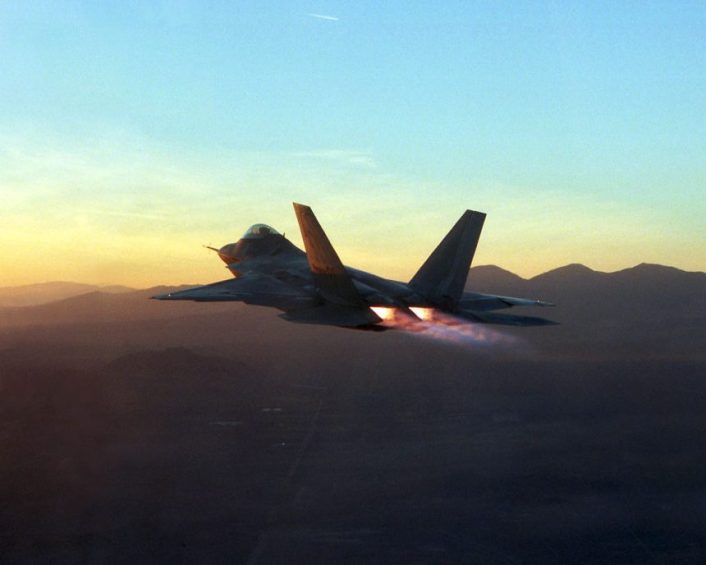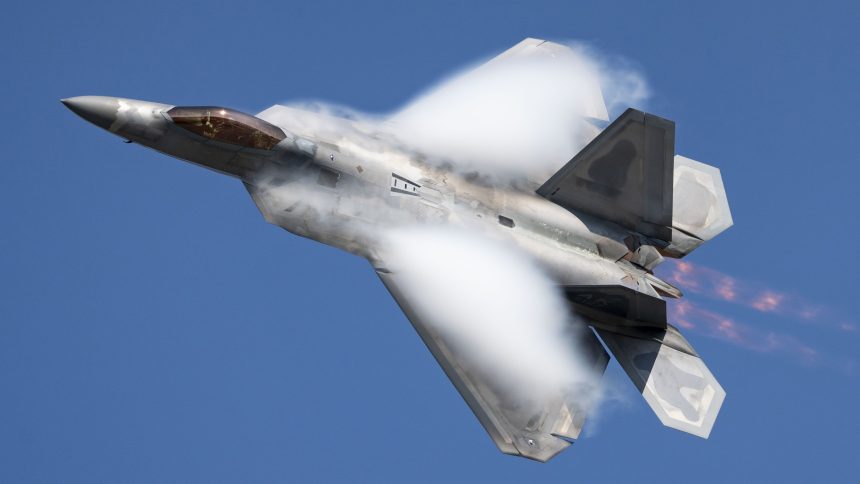The Lockheed Martin F-22 Raptor is a supersonic, twin-engine fifth-generation fighter equipped with advanced stealth technology and supercruise capability. Initially designed as an air superiority fighter, it has evolved into a versatile multirole fighter, capable of executing both air-to-air and air-to-ground operations. Developed by Lockheed Martin and used by the United States Air Force (USAF), it became the first fifth-generation jet to enter active service in 2005.
The F-22 Raptor (which was initially intended to be named “Lightning II”, a name later adopted by the F-35 Lightning II for comparison) started as a project designed to counter emerging Soviet threats of the early 1980s. The aircraft was conceived to help the U.S. regain air dominance over Europe in the event of conflict with the Soviet and Warsaw Pact Air Forces. However, their collapse and the subsequent end of the Cold War caught the F-22 still in development, with the YF-22 prototype, the prototype of the F-22 Raptor, having its maiden flight on September 29, 1990.
The “peace dividend” defense cuts following the Cold War, combined with challenges in developing the Raptor’s advanced avionics and stealth technology, delayed the program and reduced procurement numbers. At one point, the F-22 Raptor, which is manufactured by Lockheed Martin and Boeing, was even at risk of cancellation due to rising costs and shifting defense priorities.
Having survived the axe, the F-22 Raptor started production in the late 1990s, but only achieved IOC (Initial Operational Capability) in December 2005, marking its service entry date with the USAF.
Production later ended in 2011, with only 195 Raptors exiting the assembly line, highlighting the aircraft’s high cost and complexity despite its advanced F-22 specs and unmatched performance.
From then on, the Raptor was mainly used for Homeland defense, frequently intercepting Russian prowling bombers around Alaska (and famously getting the first aerial victories for the plane by shooting down Chinese spy balloons), but F-22s have also been deployed abroad in times and regions of heightened tension, becoming a frequent visitor to the Middle East and intercepting Iranian planes over the Arabian Gulf (alternatively also known as Persian Gulf).
Although the F-22 Raptor was originally developed with aerial warfare as its core application and as an air superiority fighter that is meant to replace or complement platforms just like the stablemate F-15 Eagle. Over time the Raptor took on new roles, incorporating ground attack and electronic warfare, reflecting its transition into a fully capable multirole fighter equipped with cutting-edge avionics and networked combat capabilities.
These newfound capabilities were used extensively in the Middle East, starting with operations during the Syrian Civil War.
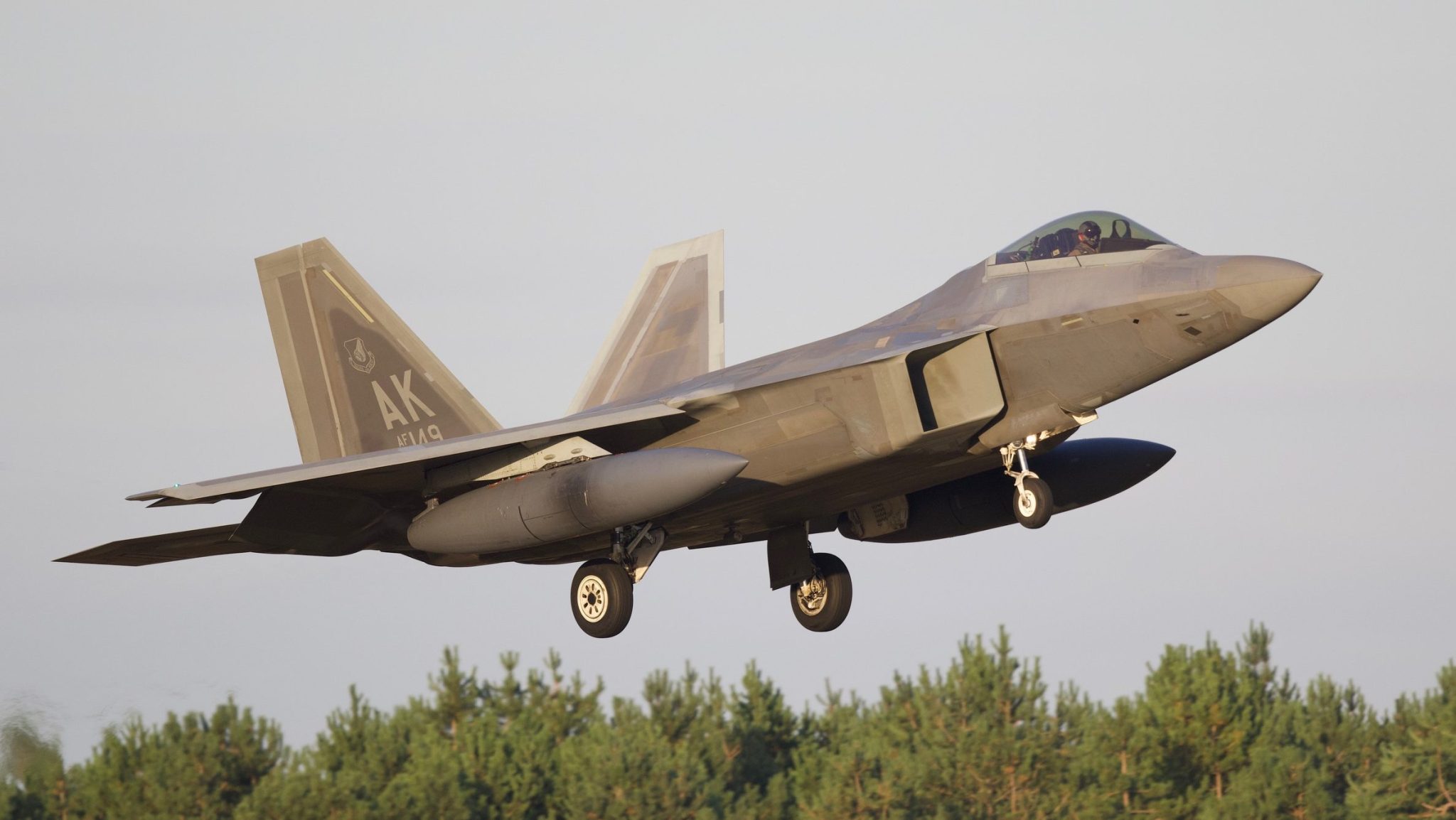
About the Lockheed Martin F-22 Raptor
The ATF (Advanced Tactical Fighter), the program that would eventually bring into existence the F-22, started in 1981 as a way to counter the emerging “triad” of Soviet threats: the new A-50 Mainstay AWACS plane, the introduction of new long-range Surface-to-Air missiles (like the mobile S-300), and the appearance of new Soviet fighters, the MiG-29 Fulcrum and Su-27 “Flanker“. The ATF aimed to integrate low-observable stealth technology, high-performance thrust vectoring, and cutting-edge avionics into a next-generation platform.
ATF responded to the threats by using new technologies in the design of the new fighter, including composite materials, advanced avionics control systems (with the F-16 having recently achieved the feat of being the first production aircraft to use digital fly-by-wire controls), more powerful propulsion systems (to allow for supercruise, that is the ability to fly supersonic without using an afterburner) and the new stealth technologies being at the time implemented extensively for the first time on the F-117 and B-2 programs.
Lockheed, who at first proposed a large design derived from the SR-71 and then a prototype inspired by the faceted F-117, finally decided on the YF-22, who in 1986 was selected for the final stage of the ATF competition, to compete (in a team with Boeing and General Dynamics) against the other finalist, the slightly stealthier and faster, but less agile YF-23 from Northrop (the maker of the B-2 Spirit stealth bomber) and McDonnell Douglas.
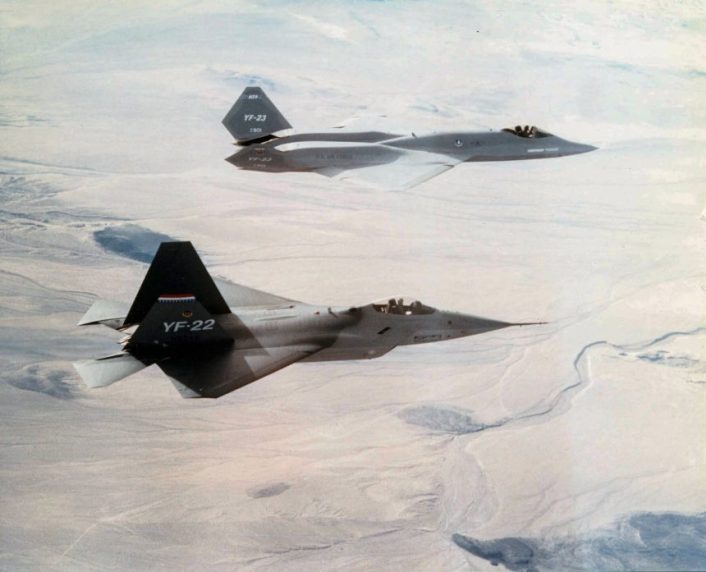
After the first flight in 1990, the Lockheed team was finally awarded the victory in the ATF program on April 23, 1991.
ATF initially envisaged 750 airframes, at a procurement cost of over $26 billion in FY1985 dollars, but already in 1990, the total had been reduced to 648, also with a later introduction date, and was further reduced to 442 in 1993
The end of the Soviet threat risked making the F-22 Raptor a “solution to a problem that didn’t exist anymore”, and in 1999, the program was even on the brink of outright cancellation.
Even if the program survived cancellation, the search for less expensive alternatives and the new focus on counterinsurgency rapidly further reduced the number, finally setting it at only 195 airframes (8 test and 187 production aircraft), despite a US Air Force requirement for 381.
The total program cost amounted to about $360 million for each production aircraft.
The Raptor’s advanced technologies and classified capabilities also restricted it to sales to other countries, with even close allies like Japan and Israel showing interest but being denied access to the jet and having to settle on the F-35.
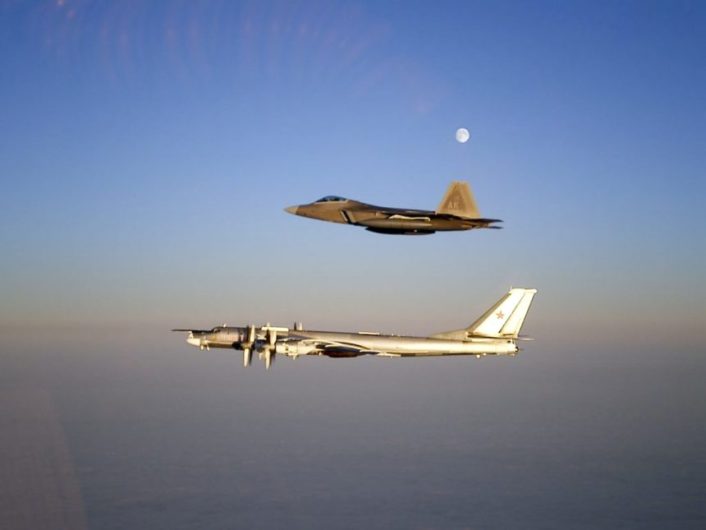
Following IOC in 2005, the F-22 flew its first homeland defense mission in January 2007 and had its first interception of a Russian bomber later in November of the same year.
Usually flying Homeland defense missions, the Raptor had its first air-to-air kill on February 4, 2023, when a 1st Fighter Wing Raptor shot down a Chinese spy balloon off South Carolina at an altitude of 60-65,000 feet (around 20,000 m). This milestone further demonstrated the aircraft’s high-altitude performance, low radar cross-section, and operational flexibility in modern aerial engagements.
Often deployed abroad to act as a deterrent, F-22s have been frequent visitors to the Middle East since 2009, with the planes conducting the type’s first combat sorties in Syria in 2014 and participating in the Battle of Kasham against Syrian troops and Russian “Wagner group” paramilitary forces in February 2018.
Interestingly, throughout the years, the role of the F-22 has evolved with the Raptor playing a pivotal role to ensure the safety of the other aircraft involved in an air campaign. In Iraq and Syria, acting as “electronic warfare enabled sensor-rich multi-role aircraft”, the Raptors escorted strike packages into and out of the target area while gathering details about the enemy systems and spreading intelligence to other “networked” assets supporting the mission to improve the overall situational awareness. In other words, the F-22 pilot leveraged advanced onboard sensors, as the AESA (Active Electronically Scanned Array) radar, to collect valuable details about the enemy Order of Battle, and share the “picture” with attack planes, command and control assets, as well as Airborne Early Warning aircraft, while escorting other manned or unmanned aircraft towards the targets as happened when they facilitated the retaliatory air strikes conducted by the Royal Jordanian Air Force F-16s after the burning alive of the pilot Maaz al-Kassasbeh captured on Dec. 24, 2014.
The USAF was expected to begin retiring the first F-22s in the 2030s to replace them with the upcoming Next Generation Air Dominance (NGAD) Sixth-generation fighter. Still, ongoing reviews of the program may extend the service of Raptors.
As of 2022, the U.S. Air Force officially operated 183 F-22 Raptors, with 149 of them being of the upgraded Block 30/35 configuration.
F-22 Raptor: Variants
F-22A
The production, single-seat F-22: 195 built (8 test and 187 production airframes).
– Block 1.0: 2 EMD test F-22
– Block 10: 6 EMD test F-22
– Block 10/20: 74 F-22A
– Block 30/35 (able to carry JDAM, SDB, AIM-9X and AIM-120D, and having EW and radar upgrades): 112 F-22A
F-22B
Planned two-seat version, cancelled in 1996.
Naval F-22
Planned carrier-borne version for the U.S. Navy’s Navy Advanced Tactical Fighter (NATF) program.
Equipped with variable-sweep wings to be able to operate from a carrier at low speed, but still be able to reach Mach 2.
Cancelled in 1991.
X-44 MANTA
Multi-Axis, No-Tail Aircraft, a planned experimental aircraft based on the F-22 but with improved thrust vectoring controls to achieve full yaw, pitch and roll authority without horizontal or vertical tailplanes. Cancelled in 2000.
FB-22
Planned supersonic stealth medium-range bomber based on an enlarged F-22, with a longer range and a 30,000 lb payload. Cancelled in 2006.
F-22/F-35 hybrid
Proposal by Lockheed Martin for the USAF and Japan, based on an F-22 airframe with increased fuel capacity and the avionics and improved stealth coatings of the F-35. Never accepted.

F-22 Raptor: Operators
The F-22 has only been in service with the United States Air Force, with 183 airframes in service as of 2022.
A total of 5 F-22s have been destroyed in crashes over the course of their career, plus a YF-22 crashed during testing.
In the Air Combat Command, they are operated by:
- 27th Fighter Squadron, 71st Fighter Squadron and 94th Fighter Squadron of the 1st Fighter Wing from Joint Base Langley-Eustis, Virginia.
- 422nd Test and Evaluation Squadron of the 53rd Wing from Eglin Air Force Base, Florida.
- 433rd Weapons Squadron of the 57th Wing from Nellis Air Force Base, Nevada.
In the Pacific Air Forces, they are operated by:
- 90th Fighter Squadron and 525th Fighter Squadron of the 3rd Wing from Joint Base Elmendorf-Richardson, Alaska.
- 19th Fighter Squadron of the 15th Wing from Joint Base Pearl Harbor–Hickam, Hawaii.
In the Air National Guard, they are operated by:
- 199th Fighter Squadron of the 154th Wing from Joint Base Pearl Harbor–Hickam, Hawaii.
- 149th Fighter Squadron of the 192nd Fighter Wing from Joint Base Langley-Eustis, Virginia.
In the Air Force Reserve Command, they are operated by:
- 302nd Fighter Squadron of the 477th Fighter Group from Joint Base Elmendorf-Richardson, Alaska.
In the Air Force Materiel Command, they are operated by:
- 411th Flight Test Squadron of the 412th Test Wing from Edwards Air Force Base, California.
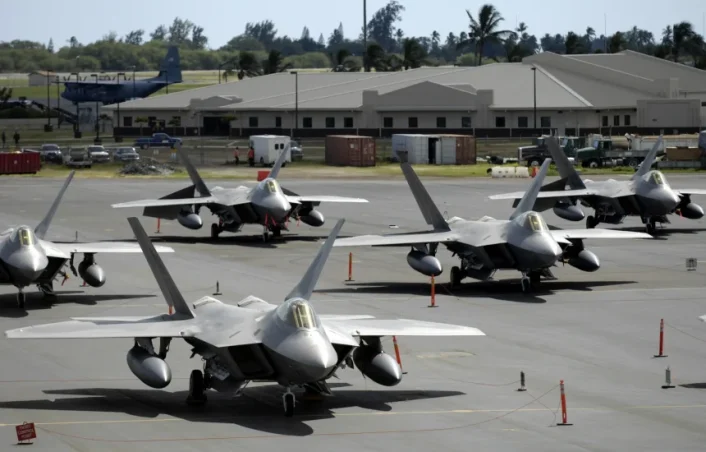
Lockheed Martin F-22 Raptor: Specifications
General Characteristics
- Crew: 1
- Length: 62 ft 1 in (18.92 m)
- Wingspan: 44 ft 6 in (13.56 m)
- Height: 16 ft 8 in (5.08 m)
- Empty weight: 43,340 lb (19,700 kg)
- Gross weight: 64,840 lb (29,410 kg)
- Fuel capacity: 18,000 lb (8,200 kg) internal, 26,000 lb (11,900 kg) with 2x 600 U.S. gallons external wing fuel tanks
- Max takeoff weight: 83,500 lb (38,000 kg)
- Powerplant: Two Pratt & Whitney F119-PW-100 turbofans, 26,000 lbf (116 kN) thrust each dry, 35,000 lbf (156 kN) with afterburner
Performance
- Maximum speed: Mach 2.25 (1,500 mph, or 2,414 km/h)
- Supercruise: Mach 1.76 (1,162 mph, or 1,870 km/h)
- Range: 1,600 nmi (3,000 km) or more with 2 external fuel tanks
- Combat range: 460 nmi (850 km) clean with 100 nmi (185 km) in supercruise
- Service ceiling: 65,000 ft (20,000 m)
- g limits: +9.0/−3.0
Armament
The Raptor has three internal weapons bays: a large central main bay split on the centerline that can host six beyond-visual-range (BVR) missiles like the AIM-120 AMRAAM and the upcoming AIM-260 JATM, and two smaller bays on the sides of the fuselage for short-range missiles like the AIM-9 Sidewinder.
Missile launches require the bay doors to be open for less than a second.
The main bay can also carry up to 2,000 lb (910kg) of air-to-ground ordnance (2x 1,000 lb JDAM or 8x 250 lb GBU-39 SDB) while at the same time carrying 2x AIM-120.
Lockheed also recently unveiled the 1,300 lb (590kg) Mako hypersonic missile that can be carried internally.
The Raptor right wing root hosts an M61A2 Vulcan 20 mm rotary cannon with 480 rounds, and with the muzzle covered by a retractable door to maintain the plane’s stealth characteristics.
The wings have four hardpoints, each rated to handle 5,000 lb (2,300 kg).
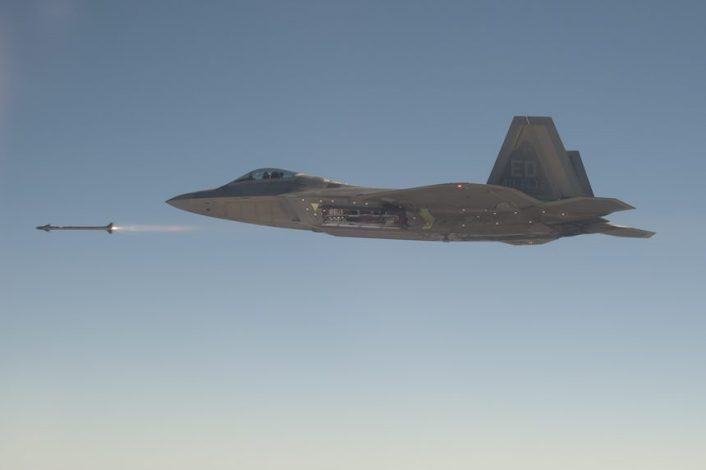
Top F-22 Raptor Milestones
- ATF program started: 1981
- YF-22 first flight: September 1990
- ATF program awarded to the F-22: April 23, 1991
- F-22 production: 1996-2011
- First flight of the F-22: Sept. 7, 1997
- F-22A delivery: September 2003
- F-22A in service: Dec. 15, 2005
- F-22A Full Operational Capability (FOC): December 2007
- F-22A first homeland defense mission: January 2007
- F-22A first overseas deployment: February 2007
- F-22A first North American Aerospace Defense Command (NORAD) interception of Russian bombers: November 2007
- First ever air-to-air refueling of an aircraft using synthetic jet fuel: August 2008
- F-22 first supersonic flight on a 50% mixture of biofuel: 2011
- F-22A first deployment in the Middle East: 2009
- F-22A first combat sortie: Sept. 22, 2014
- F-22A first air-to-air kill (against a Chinese spy balloon): Feb. 4, 2023
- F-22A shoots down a “high altitude object” over Alaska on Feb. 10, 2023
- F-22A shoots down mysterious aircraft over Canada: Feb. 11, 2023.
